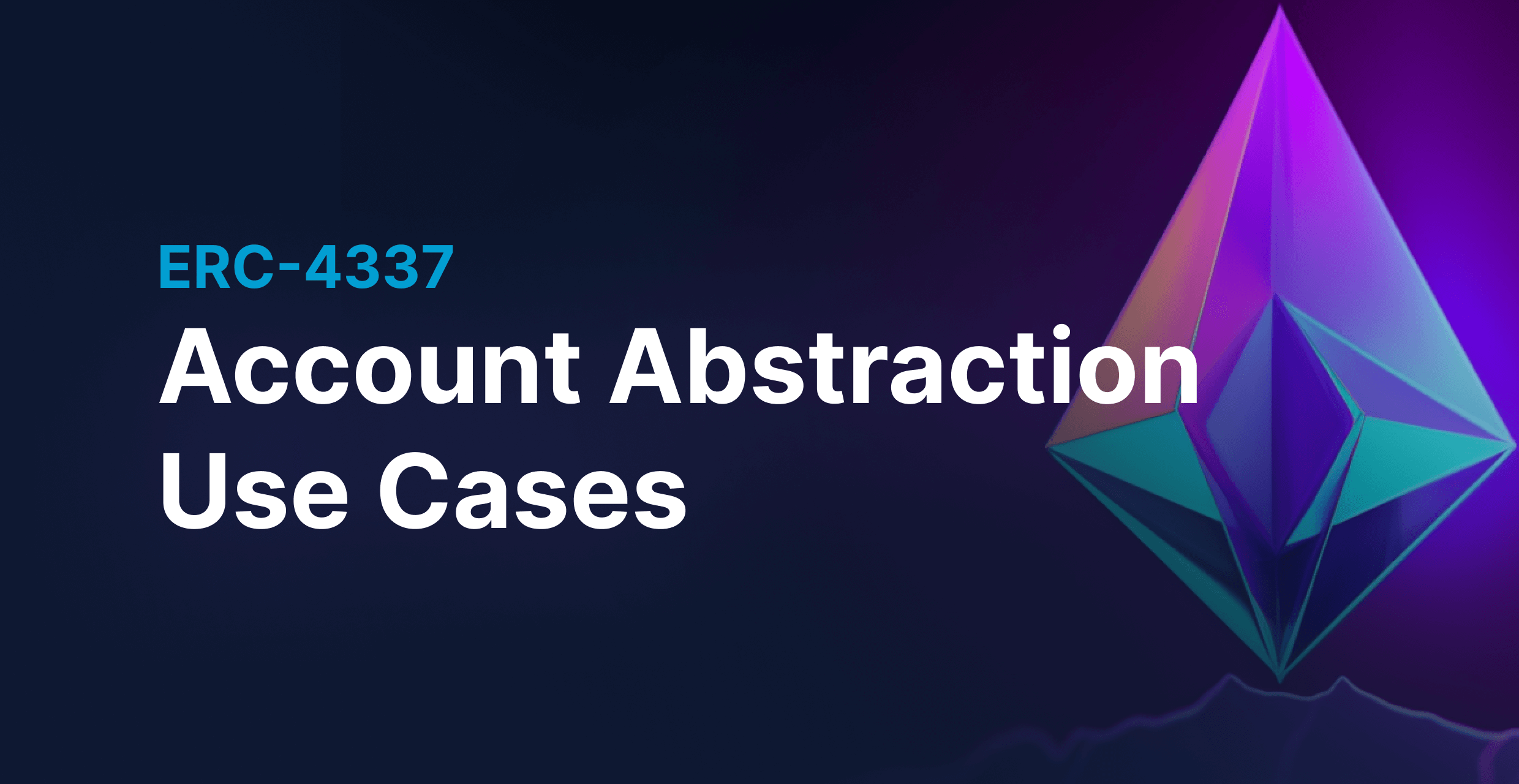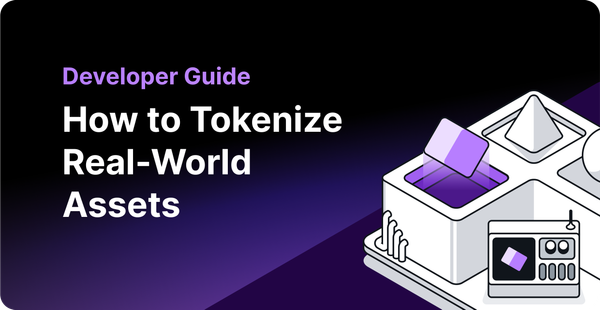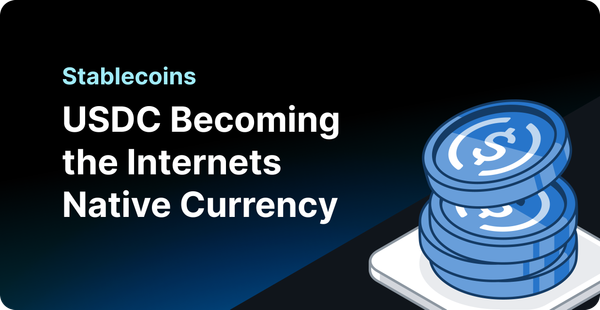Account Abstraction Use Cases That Will Redefine Web3
Account abstraction is an Ethereum upgrade that enables the creation of web3 wallets that are highly customizable. Learn about its use cases.

The blockchain and cryptocurrency space is undergoing a subtle transformation. The novelty effect is waning. People are rightfully seeking more practical grounds to support the space.
Before this, the early adopters managed with subpar user experience, thanks to the initial WOW factor, genuine technological curiosity, and generational wealth prospects.
However, now, the order of the day in web3 is simplicity and functionality.
In this pursuit, account abstraction is leading the charge to transform blockchain and cryptocurrency from being exceptional tech to everyday tools.
Introduced through the Ethereum improvement proposal 4337 (EIP-4337), account abstraction is an Ethereum update that treats user accounts (externally owned accounts or EOAs) and smart contracts the same way.
That means smart contracts can now function as standalone web3 wallets without the need for an EOA to trigger or approve transactions.
Dubbed ‘smart accounts,’ they negate the need for users to manage a single private key or seed phrase and allow for various types of complex transactions.
In this article, we will explore the various use cases of account abstraction and how it makes the web3 user experience simpler and more practical.
Use Cases of Account Abstraction
Account abstraction has multiple use cases. Let’s break it down into different segments.
Improved Wallet Security and Recovery
1. Multi-signature transactions
In cases of wallets associated with DAOs, grants, companies, or other organizations, it’s important that no entity or person can singlehandedly execute transactions.
Using smart accounts, anyone can set up multi-signature transactions in a wallet. That means, a transaction would only execute from a multi-sig wallet when a minimum specified number of entities or people sign the transaction.
2. Social recovery
Unlike EOAs, smart accounts do not wholly rely on a single private key or seed phrase. They allow users to generate a new key to access the same account in case they lose their original key.
This is possible through social recovery.
Social recovery lets users create a multi-signature setup with trusted guardians (devices or users). If a user loses their key, they can have the guardians sign a transaction and regain access to the wallet.
This serves both as a psychological comfort and a technical safeguard.
Customizable Smart Contract Interactions
3. Contract/account whitelisting
Account abstraction adds the possibility for users to create a whitelist of smart contracts they can interact with. These smart contracts can potentially either be user-owned accounts or those operating dapps.
For example, a company’s account can be configured to transact with the addresses of employees only. So, even if a hacker gains control of the company’s account, they wouldn’t be able to drain the funds to any other account apart from that of an employee.
It would also prevent anyone from mistakenly sending funds to a wrong or non-existing wallet address.
4. Transaction batching
There are web3 interactions that require multiple steps to complete. For example, when using a DEX to swap a new token, you first need to approve the token and then approve the transaction.
With the ‘multi-call’ function in smart accounts, users can batch actions like these into a single transaction. So, when you go to a DEX, you can approve the token and execute the swap in a single transaction instead of approving two separate ones.
Apart from improving the user experience, this can also significantly reduce the overall gas consumption for transactions.
More Secure Web3 Experiences
5. Session keys
Earlier, anyone with the seedphrase or private key could access the corresponding web3 account at any time. Now, users can set up temporary access keys called session keys that an authorized user can use for a pre-defined duration or number of transactions.
Session keys, being temporary, reduce the risk associated with key exposure. Even if a session key is compromised, it would only provide access for a limited time or a restricted set of actions, safeguarding the assets linked to the primary key.
To be safer, the session keys can be programmed with a revoke access function, which can be called either from a single account or through a multi-sig transaction.
6. Tiered wallet access
Account abstracted wallets or smart accounts are capable of customized user permissions. Hence, a wallet owner can assign (and revoke) dynamic roles such as 'admin,' 'user,' 'auditor,' etc., for the same account.
Owners can also define spend limits for all individual users of the wallet and freeze accounts in case of any potential threats. This can be extremely useful for accounts managed by different types of organizations.
7. Spending limits
Another utility of AA is the ability to set spending limits for smart accounts. So, one can define how much funds can be transacted/withdrawn in a set period.
With spending limits in place, even if a malicious actor gains access to the account, the potential damage they can inflict is contained.
Users can also tailor the spending limit in a way that for a larger transaction, they need a multi-sig approval. Or they can define spend limits for specific dApps to avoid overspending.
Flexible Network Fees (Gas) Options
8. Custom gas tokens
One of the major restrictions within Ethereum has been the inability to use any other token apart from ETH to pay for transaction gas. Account abstraction changes that.
Smart account owners can choose their preferred token to pay the gas fees for their transactions. So, even if you do not own ETH in your account, you may still be able to execute transactions.
9. Subsidized gas fees
When you conduct a transaction with an EOA, you must pay your gas. But smart accounts do not necessarily have to. They are compatible with sponsored gas fees.
That is to say, dApps or companies in web3 can choose to pay for the network fees that users incur when conducting a transaction on their platform.
This can be extremely useful to improve the user-onboarding experience or while launching NFTs or airdrops. The involved entity can subsidize the gas fees and users can mint the NFTs or claim their airdrops without paying any gas.
Account Abstraction in Different Web3 Ecosystems
This is a brief overview of how AA is being implemented in various blockchain ecosystems.
Ethereum
We have discussed a lot about the use cases of AA in Ethereum. Let’s see a couple of live applications of AA.
0xPass is a streamlined wallet connector that improves the "Connect Wallet" experience. It serves as a bridge between web2 and web3 login methods, enabling user-friendly authentication and efficient user management.
AA makes this possible to create flexible login with web2 and web3 options and also build user profiles using their verifiable social accounts like Google and Twitter.
Obvious is a self-custody wallet designed for cross-chain transactions across EVM chains. It offers a smart wallet, built on the ERC-4337 proposal. Additionally, users can pay gas fees with any token using the "Pay Any" feature. They also offer a unique MPC-based "Seedless Recovery" system.
Layer-2 Solutions
We know that layer-2 solutions enhance blockchain scalability and transaction speeds. Account abstraction on Ethereum can further amplify these solutions' capabilities.
Here are some possibilities:
1. Enables gas efficiency improvements in rollups.
By using account abstraction, transactions within rollups can adopt flexible gas models, potentially allowing third parties to sponsor or subsidize the transaction costs for users.
2. Facilitates seamless cross-Layer-2 interoperability.
The flexible transaction validation rules provided by account abstraction can make interactions between different Layer-2 solutions more efficient and seamless.
3. Allows dynamic fee structures within state channels.
State channels can harness account abstraction to create varied fee mechanisms, enabling participants to split, subsidize, or pay fees using alternative tokens.
For instance, let’s take the example of Friend.tech on Base
Base is an Ethereum L2 and is home to Friend.tech, a decentralized social network designed to tokenize and monetize user credibility. Account abstraction has been a key design principle that Friend.tech has followed throughout their user journey.
Simple onboarding: Users can sign up with their Google accounts and connect to their Twitter effortlessly.
Mobile optimization: Their mobile-first interface ensures easy navigation and interaction.
Gasless interactions: Eliminates the need for users to sign transactions or bear gas fees.
Non-EVM Chains
Account abstraction primarily relates to Ethereum and Ethereum virtual machine (EVM). However, the idea can be conceptually extended to non-EVM chains.
Here are three potential applications for account abstraction in such environments.
1. Interoperability with EVM chains: Adopting account abstraction on non-EVM chains can streamline interactions with EVM chains, simplifying cross-chain transfers of assets and data.
2. Smart account by default: Account abstraction helps create a unified blockchain system where every account by default is a smart contract. Eases up the onboarding process.
3. In-built privacy: AA allows each account to be embedded with privacy settings, allowing for concealed balances and transaction details or integrating zero-knowledge proofs.
Talking about AA and non-EVM chains, we should focus on the Flow blockchain.
Here is what they have to offer:
Smart contract accounts: Every account is a SCA on Flow. Users can configure access and security settings easily.
Hybrid custody: AA allows users to seamlessly switch between self-custody and app-custody. Initially, users can sign up without a wallet, and later delegate control to their self-custody account.
Walletless onboarding: dApps on Flow can initiate the user registration on the users’ behalf, eliminating the necessity for user wallet authentication during the onboarding process.
The Potential of Account Abstraction
The best technology is invisible. That’s why we aren’t WOW-ed by an email coming from across the globe, which is truly a technological marvel.
Account abstraction is a potential way for developers to finally push technicalities to the back seat and let users experience the potential of web3 in a seamless way. It might be the tool we need to make blockchain, cryptocurrency, and NFTs evolve from being exceptional tech to everyday tools.
It’s now upon developers to hyper-focus on user experience since they have the tooling figured out.
We hope this blog helped you understand the use cases of account abstraction. If you have any queries about it, feel free to drop us a word on Discord.

About QuickNode
QuickNode is building infrastructure to support the future of Web3. Since 2017, we've worked with hundreds of developers and companies, helping scale dApps and providing high-performance access to 24+ blockchains. Subscribe to our newsletter for more content like this, and stay in the loop with what's happening in Web3!





